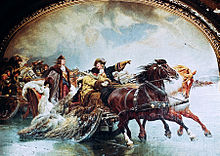Wilhelm Simmler
Wilhelm Carl Melchior Simmler (born September 6, 1840 in Geisenheim , † December 8, 1923 in Berlin ) was a German painter and illustrator at the Düsseldorf School of Painting .
family
Simmler was one of nine children of the painter Friedrich Simmler (1801–1872). His siblings Joseph Simmler (1842–1899), Franz Joseph Simmler (1846–1926) and Antonia Simmler (1852–1923) were also artistically active.
Live and act
Simmler was born in the Rheingau . From 1856 to 1861 he studied at the Düsseldorf Art Academy . There he was a student of Emil Hünten , Karl Ferdinand's son , Friedrich Wilhelm von Schadow , Christian Köhler and Eduard Bendemann, among others . After intermediate stays in Munich from 1861 to 1863, he stayed mainly in Düsseldorf from 1869 onwards. His private student was the British genre painter Walter Dendy Sadler from 1871 to 1875 . Simmler was a member of the Malkasten artists' association . After several assignments, including in Hamburg and Berlin, he finally moved to Berlin in 1891, where he was a member of the Berlin Artists' Association until his death .
plant
He particularly stood out for his history paintings , genre scenes and hunting motifs, which already distinguished him as a successful artist during his lifetime. From 1862 he was represented at exhibitions in Berlin, Düsseldorf and Berlin. In later years he painted panoramas and murals . In cooperation with Emil Hünten, Simmler produced the panorama of the storm on St. Privat for the Berlin panorama rotunda "Nationalpanorama" in Herwarthstrasse, which opened in February 1881. In 1883 the panorama was removed and later shown in Cologne and Hamburg. In 1882, the Orient panorama “Entry of the Mecca Caravan into Cairo” by Simmler and Themistocles von Eckenbrecher (118 × 15 meters) for the city of Hamburg followed. Around 1891 he made the mural “ Crossing over the Curonian Lagoon from January 19, 1679 ” for the Hall of Fame in Berlin , which was destroyed by a bomb during the Second World War in 1944.
Simmler also produced illustrations for books for children and young people, such as the templates for the color prints for an edition of “The Adventures of Baron von Münchhausen” by Gottfried August Bürger .
literature
- Friedrich Schaarschmidt: On the history of Düsseldorf art especially in the XIX. Century . Art Association for the Rhineland and Westphalia, Düsseldorf 1902, p. 325–326 ( Text Archive - Internet Archive ).
- Simmler, Wilhelm . In: Hans Vollmer (Hrsg.): General lexicon of fine artists from antiquity to the present . Founded by Ulrich Thieme and Felix Becker . tape 31 : Siemering – Stephens . EA Seemann, Leipzig 1937, p. 48-49 .
- Hans Paffrath (Ed.): Lexicon of the Düsseldorf School of Painting 1819–1918. Volume 3: Nabert-Zwecker. Published by the Kunstmuseum Düsseldorf in the Ehrenhof and by the Paffrath Gallery. Bruckmann, Munich 1998, ISBN 3-7654-3011-0 , p. 288.
- Matthias Lehmann: Friedrich Simmler (1801–1872). Life and work of the painter from Geisenheim. Fichter, Frankfurt 2012, ISBN 978-3-9814023-5-3 , p. 246. 343-359.
Web links
- Wilhelm Simmler ( Memento from August 14, 2016 in the Internet Archive ), short biography at Galerie Paffrath
- Wilhelm Simmler (German, 1840–1914). Artnet.de
Individual evidence
-
↑ A relationship of the family in Switzerland or a relationship with the painter Johannes Simmler (1693–1748) or the natural scientist Josias Simmler (1530–1576) cannot be proven;
Matthias Lehmann: Friedrich Simmler (1801–1872). Life and work of the painter from Geisenheim. Fichter, Frankfurt 2012, ISBN 978-3-9814023-5-3 , p. 11. - ↑ Bettina Baumgärtel , Sabine Schroyen, Lydia Immerheiser, Sabine Teichgröb: Directory of foreign artists. Nationality, residence and studies in Düsseldorf. In: Bettina Baumgärtel (Hrsg.): The Düsseldorf School of Painting and its international impact 1819–1918. Michael Imhof Verlag, Petersberg 2011, ISBN 978-3-86568-702-9 , Volume 1, p. 439.
- ^ Karin Rhein: German Orientmalerei in the second half of the 19th century. Tenea, Berlin 2005, ISBN 3-86504-035-7 , p. 98.
- ↑ Hans Ries: Illustration and Illustrators of Children's and Young People's Books in German-Speaking Areas 1871-1914. Wenner, Osnabrück 1992, ISBN 3-87898-329-8 , p. 886 (directory).
- ^ Hoffmann, Stuttgart 1871, 9th edition 1906; Reprint Gottfried August Bürger: The Adventures of Baron von Münchhausen. Mescheryakov publishing house, Vienna 2010, ISBN 978-3-902755-12-4 .
| personal data | |
|---|---|
| SURNAME | Simmler, Wilhelm |
| ALTERNATIVE NAMES | Simmler, Wilhelm Carl Melchior (full name) |
| BRIEF DESCRIPTION | German painter |
| DATE OF BIRTH | September 6, 1840 |
| PLACE OF BIRTH | Geisenheim |
| DATE OF DEATH | December 8, 1923 |
| Place of death | Berlin |
